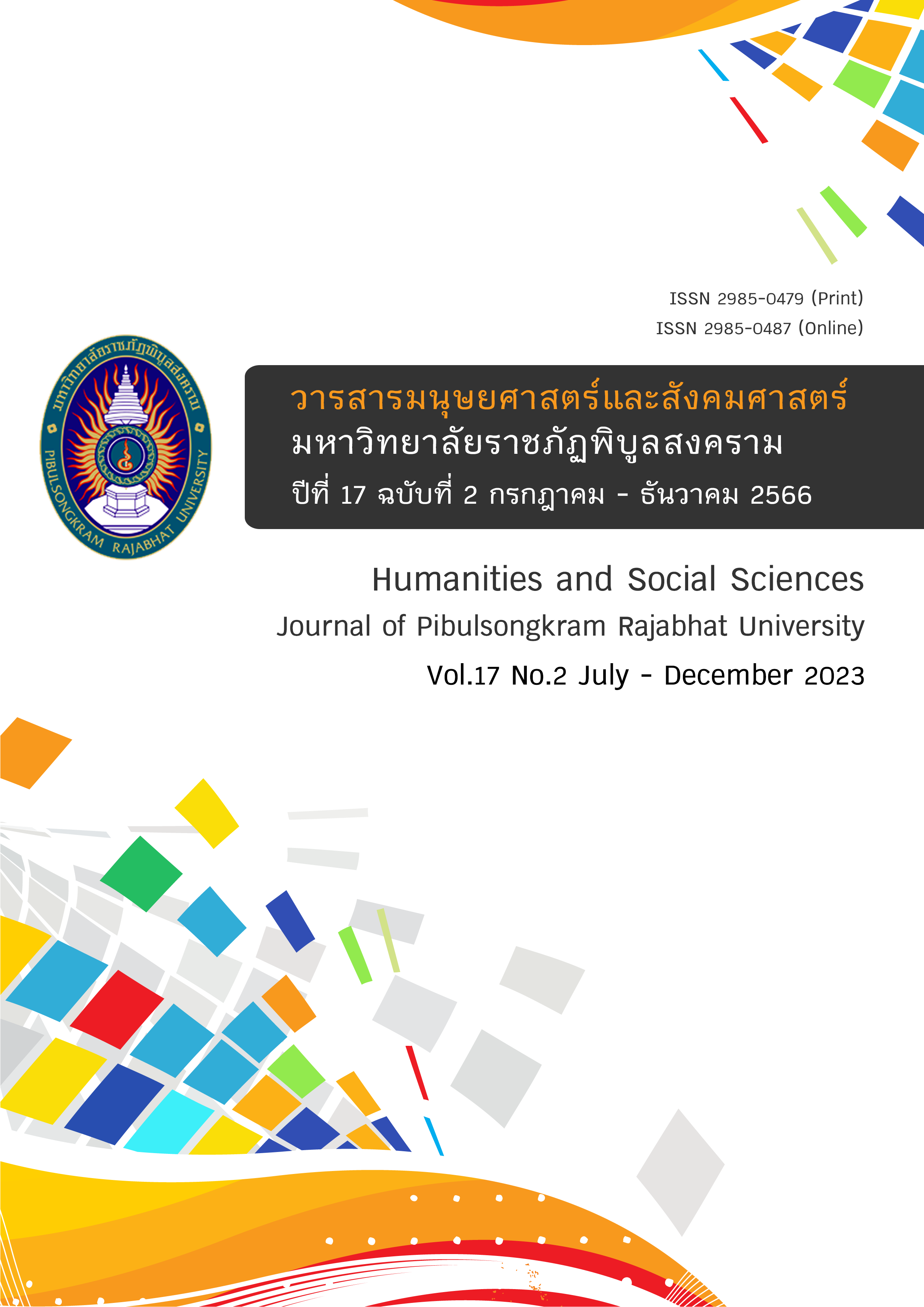The Promotion of Esports Image to the People in Thailand
DOI:
https://doi.org/10.14456/psruhss.2023.34Keywords:
Perception, Image, EsportsAbstract
The purposes of this research were to 1) to study the level of public perception of esports images 2) to compare the level of public perception of esports images in each generation and 3) to study ways to promote the image of esports in Thailand. The researcher used mixed-method research. By using questionnaires to collect quantitative data from 4 generations of Thai citizens who playing esports games, watching games or esports competition 400 samples. And use in-depth interviews to collect qualitative data from key informants who are related or who have stakeholders, experienced and proficient in esports, both public sectors, private sectors, and citizens 10 persons. Statistics used to analyze quantitative data include: frequency, percentage, average, standard deviations, The one-way analysis of variance (ANOVA) and Scheffe's method tests. Statistics used to analyze qualitative data include: content analysis and interpretation. The research found that 4 generations of Thai citizens who playing esports games, watching games or esports competition have a high level of awareness of the esports image, and the perception of the esports image differs at the statistical significance level of 0.05. Guidelines for promoting the image of esports to the people in Thailand include: Presenting the positive impact on the body of esports gaming, Presenting practical ways to reduce the negative impact on the body, Creating a sports idol, Presenting news about value or revenue from the esports industry, Publicizing knowledge about esports to the public, Organizing ongoing training and seminars to educate the public, Building knowledge and understanding for parents, and Creating a practice for parents to supervise their children.
References
กาญจนาถ อุดมสุข, และจารุดี แก้วมา. (2562). เปิดมุมมองกีฬาอิเล็กทรอนิกส์ E-sport ประเทศไทย. วารสารงานวิจัยและพัฒนา มหาวิทยาลัยราชภัฏศรีสะเกษ, 6(2), 1-14.
เตชิต ธนะจันทร์. (2558). การรับรู้ภาพลักษณ์ฟุตบอลทีมชาติไทย ภายใต้การบริหารงานของเกียรติศักดิ์ เสนาเมือง ของผู้ใช้แฟนเพจ “ฟุตบอลทีมชาติไทย” (การค้นคว้าอิสระปริญญามหาบัณฑิต). กรุงเทพฯ: มหาวิทยาลัยธรรมศาสตร์.
ไทยโพสต์. (2561). แค่ 6 เดือน "E-Sport " ทำให้เด็กต้องเข้ารับการบำบัดแล้ว 60 คน จิตแพทย์ห่วงเตรียมนำประเด็นถกสมัชชาสุขภาพ. สืบค้น 31 มีนาคม 2563, จาก https://www.thaipost.net/main/detail/17222.
ประชาชาติธุรกิจ. (2563). ทำไมใคร ๆ ก็สนใจ “อีสปอร์ต” “เอไอเอส” ย้ำ 4C สร้างการเติบโต. สืบค้น 31 พฤษภาคม 2563, จาก https://www.prachachat.net/ ict/news-493634.
เปรม ถาวรประภาสวัสดิ์. (2561). อนาคตของอีสปอร์ตในประเทศไทย. สืบค้น 31 มีนาคม 2563, จาก https://library2.parliament.go.th/ebook/content-issue/2561/hi2561-073.pdf.
พนม คลี่ฉายา. (2561). การรู้เท่าทันเกมของนักเรียนมัธยมศึกษาในประเทศไทย. วารสารนิเทศศาสตรปริทัศน์, 22(1), 31-54.
ภัสร์ภรณ์ เหลืองทอง. (2562). คณะทำงานขับเคลื่อนสมัชชาสุขภาพเผยมาตรการแนวทางแก้ไขปัญหาทางสังคมเกี่ยวกับอีสปอร์ต. สืบค้น 20 พฤษภาคม 2564, จาก https://nbtworld.prd.go.th/th/news/detail/TCATG190430170159071.
แวดวงอีสปอร์ต. (2560). 5 ปัญหาวงการอีสปอร์ตในปีที่ผ่านมา. สืบค้น 3 เมษายน 2563, จาก https://www.facebook.com/eSportsCircles/posts/1417793741669847/.
ศศิมา ตุ้มนิลกาล. (2560). การนำเสนออัตลักษณ์บนเครือข่ายสังคมออนไลน์อินสตาแกรมของเจเนอเรชั่น: กรณีศึกษาความแตกต่างระหว่างเจเนอเรชั่นเอ็กซ์ เจเนอเรชั่นวาย และเจเนอเรชั่นแซด (การค้นคว้าอิสระปริญญามหาบัณฑิต). กรุงเทพฯ: มหาวิทยาลัยกรุงเทพ.
สถาบันบัณฑิตพัฒนบริหารศาสตร์. (2561). E-sport กีฬาอิเล็กทรอนิกส์ ในมุมมองคนไทย. สืบค้น 31 มีนาคม 2563, จาก http://www.nidapoll.nida.ac.th/file_upload/poll/document/2018093008 2147.pdf
สมัชชาสุขภาพแห่งชาติ. (2561). ความรับผิดชอบร่วมทางสังคมเกี่ยวกับอีสปอร์ตต่อสุขภาวะเด็ก. สืบค้น 14 ตุลาคม 2563, จาก https://www.nationalhealth.or.th/_external/main_esport_ 24_8_61.pdf
สำนักงานกองทุนสนับสนุนการสร้างเสริมสุขภาพ. (2563). หวั่นอีสปอร์ตแฝงพนัน ทำเด็กติดเกมสุขภาพแย่. สืบค้น 3 เมษายน 2563, จาก https://www.thaihealth.or.th/ Content/51016-หวั่นอีสปอร์ตแฝงพนัน%20ทำเด็กติดเกมสุขภาพแย่.html.
สำนักงานคณะกรรมการสุขภาพแห่งชาติ. (2561). ผลกระทบของอีสปอร์ตที่มี ต่อสุขภาวะเด็กและการสร้างรูปแบบความรับผิดชอบร่วมของหน่วยงานที่เกี่ยวข้อง. สืบค้น 3 เมษายน 2563, จาก https://www.nesdc.go.th/ewt_w3c/ewt_news.php? nid=8949&filename=.
สำนักงานสภาพัฒนาการเศรษฐกิจและสังคมแห่งชาติ. (2562). ภาวะสังคมไทยไตรมาสหนึ่ง ปี 2562. สืบค้น 17 ตุลาคม 2563 จาก http://social.nesdc.go.th/social/ Portals/0/Documents/PPT_Q1-2562_03092019_2295.pdf.
สุภารักษ์ จูตระกูล. (2559). ครอบครัวกับการรู้เท่าทันสื่อดิจิทัล (Digital Literacy) ของดิจิทัลเนทีฟ (Digital Natives). วารสารวิทยาการจัดการ มหาวิทยาลัยราชภัฏเชียงราย, 11(1), 99-118.
สุรศักดิ์ ประสาร. (2558). ภาพลักษณ์องค์กรที่มีผลต่อแรงจูงใจในการเข้าทำงานโรงแรมของนักศึกษา สาขาการท่องเที่ยวและการโรงแรมที่ศึกษาในจังหวัดมหาสารคาม (วิทยานิพนธ์ปริญญามหาบัณฑิต). มหาสารคาม: มหาวิทยาลัยมหาสารคาม.
เสมอ นิ่มเงิน. (2561). Generation กับพฤติกรรมการรับข่าวสารผ่านสื่อต่าง ๆ. สืบค้น 24 พฤษภาคม 2564, จาก http://edoc.mrta.co.th/HRD/Attach/1566372710_1.pdf.
เหวินย่วน หลิว. (2560). อิทธิพลของภาพลักษณ์นักกีฬาในสื่อกระแสหลักที่มีต่อการเลือกชมรายการกีฬาของนักศึกษาในเมืองหนานหนิง มณฑลกว่างซี ประเทศจีน (การค้นคว้าอิสระปริญญามหาบัณฑิต). กรุงเทพฯ: มหาวิทยาลัยกรุงเทพ.
อำพล อสิพงษ์. (2562). แนวทางการพัฒนากีฬาอิเล็กทรอนิกส์ในประเทศไทย (การค้นคว้าอิสระปริญญามหาบัณฑิต). กรุงเทพฯ: มหาวิทยาลัยรามคำแหง.
Best, W., J., & Kahn. V., J. (1993). Research in Education. MA: Needham Heights.
Hayat, T. (2017). Sport Athletes as Role Models. Retrieved 20 May 2021, from https://www.academia.edu/31598823/SPORT_ATHLETES_AS_ROLE_MODELS.
Downloads
Published
How to Cite
Issue
Section
License
Copyright (c) 2023 Humanities and Social Sciences Journal of Pibulsongkram Rajabhat University

This work is licensed under a Creative Commons Attribution-NonCommercial-NoDerivatives 4.0 International License.
Any articles or comments appearing in the Journal of Humanities and Social Sciences, Rajabhat Phibulsongkram University, are the intellectual property of the authors, and do not necessarily reflect the views of the editorial board. Published articles are copyrighted by the Journal of Humanities and Social Sciences, Rajabhat Phibulsongkram University.









